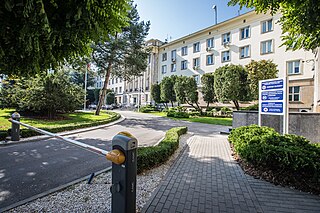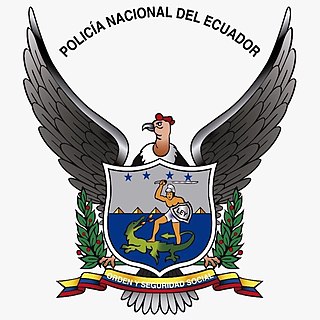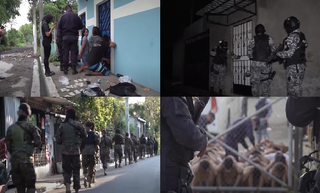
Crime in Ecuador is investigated by the Ecuadorian police.

Crime in Ecuador is investigated by the Ecuadorian police.
In 2012, Ecuador had a murder rate of 12.4 per 100,000 population. [1] There were a total of 1,924 murders in Ecuador in 2012. [1] By 2014, this had decreased to 8.23 per 100,000, with 1,309 murders recorded that year, [2] but since 2019 the number of homicides, often related to organized crime and narcotraffic operations, has risen to 14 per 100,000 in 2021 while widespread corruption throughout ineffective and weak political institutions provided only a weak answer to the mounting violence. [3] In April 2022, the provinces of Guayas, Manabi, and Esmeraldas were all declared in state of emergencies for 60 days by Ecuadorean President Guillermo Lasso. It was reported that there is a rise in violent deaths and crimes in the said provinces this year. Along with this, 9,000 police and military are said to patrol the streets in the provinces during the 60 days. [4]
In a 2009 diplomatic cable from the United States diplomatic cables leak released in April 2011, U.S. Ambassador Heather Hodges said that "corruption among Ecuadorian National Police officers is widespread and well-known" and that "U.S. investors are reluctant to risk their resources in Ecuador knowing that they could be targeted by corrupt law enforcement officials." [5] [6]
Domestic terrorist groups present in Ecuador include the Popular Combatants Group (PCG), the Revolutionary Militia of the People, the Marxist-Leninist Party of Ecuador, and the Alfarista Liberation Army. [7] Foreign groups include the Colombian groups Revolutionary Armed Forces of Colombia (FARC) and National Liberation Army (ELN). [7]
Although prohibited by law, domestic violence in Ecuador is a human rights problem. [8] In a 2008 survey, 32.4% of the women interviewed aged 15–49 said they had suffered physical or sexual violence by a current or former partner. [9]
Conflict in Ecuador among rival drug trafficking gangs and the Ecuadorian government has been common. Initially taking place within prisons between rival gangs, it has since expanded outside of prisons and attracted the participation of numerous outside criminal syndicates.

Crime is one of the most urgent concerns facing Mexico, as Mexican drug trafficking rings play a major role in the flow of cocaine, methamphetamine, fentanyl, heroin, and marijuana transiting between Latin America and the United States. Drug trafficking has led to corruption, which has had a deleterious effect on Mexico's Federal Representative Republic. Drug trafficking and organized crime have been a major source of violent crime. Drug cartels and gangs have also branched out to conduct alternative illegal activities for profit, including sex trafficking in Mexico. Some of the most increasingly violent states in Mexico in 2020 included Guanajuato, Zacatecas, Michoacán, Jalisco, and Querétaro. Some of the world's most violent cities are reportedly within the state of Guanajuato with extortion from criminal groups now being commonplace. The state of Zacatecas is said to be valuable to multiple organized crime groups for drug trafficking, specifically methamphetamine to the United States. As of 2021, Michoacán is experiencing increased instances of extortion and kidnapping due to a growing presence and escalation in the armed conflicts between CJNG and Cárteles Unidos on regions bordering the neighboring state of Jalisco. CJNG is also currently battling the Los Chapitos faction of the Sinaloa Cartel in the North Mexican region of Sonora.
Crime in Chicago has been tracked by the Chicago Police Department's Bureau of Records since the beginning of the 20th century. The city's overall crime rate, especially the violent crime rate, is higher than the US average. Gangs in Chicago have a role in the city's crime rate. The number of homicides in Chicago hit a 25-year high in 2021.

Crime in Brazil involves an elevated incidence of violent and non-violent crimes. Brazil's homicide rate was 21.26 per 100,000 inhabitants in 2021, according to the United Nations Office on Drugs and Crime (UNODC). Brazil has one of the highest number of intentional homicides in the world with 57,358 in 2018. In recent years, the homicide rate in Brazil has begun to decline. The homicide rate was 20.89 per 100,000 in 2019 with 43,073 killings, down from 30.59 per 100,000 with 63.788 killings in 2017.

Crime and violence affect the lives of millions of people in Latin America. Some consider social inequality to be a major contributing factor to levels of violence in Latin America, where the state fails to prevent crime and organized crime takes over State control in areas where the State is unable to assist the society such as in impoverished communities. In the years following the transitions from authoritarianism to democracy, crime and violence have become major problems in Latin America. The region experienced more than 2.5 million murders between 2000 and 2017. Several studies indicated the existence of an epidemic in the region; the Pan American Health Organization called violence in Latin America "the social pandemic of the 20th century." Apart from the direct human cost, the rise in crime and violence has imposed significant social costs and has made much more difficult the processes of economic and social development, democratic consolidation and regional integration in the Americas.

Crime in Poland refers to the incidence, deterrence, and handling of criminal activity in the Republic of Poland by Polish law enforcement agencies charged with ensuring public safety and maintaining order. Poland ranks favorably in terms of public safety, with one of the lowest homicide rates in Europe. Poland was ranked 25th in the 2022 Global Peace Index and scored 0.0 on the 2023 Global Terrorism Index.

Crime in Paraguay has increased in recent years with criminals often targeting those thought to be wealthy. Although most crime in Paraguay is nonviolent, there has been an increase in the use of weapons and there have been incidents where extreme violence has been used.
Crime in Haiti is investigated by the Haitian police. Since the late 2010s, the country has suffered from widespread gang warfare and civil unrest, including a massive prison breakout in 2024. It also suffers from extreme corruption and high levels of sexual violence.

Slovakia is a Central European country with a history of relatively low crime. While crime became more widespread after the Revolutions of 1989, it remains low when compared to many other post-communist countries.

The National Police of Ecuador is the national police force and the main civil law enforcement agency of Ecuador. It is commanded by the Commanding General and subordinate to the Ministry of the Interior.
Colombia has a high crime rate due to being a center for the cultivation and trafficking of cocaine. The Colombian conflict began in the mid-1960s and is a low-intensity conflict between Colombian governments, paramilitary groups, crime syndicates, and left-wing guerrillas such as the Revolutionary Armed Forces of Colombia (FARC), and the National Liberation Army (ELN), fighting each other to increase their influence in Colombian territory. Two of the most important international actors that have contributed to the Colombian conflict are multinational companies and the United States.
Crime in Venezuela is widespread, with violent crimes such as murder and kidnapping increasing for several years. In 2014, the United Nations attributed crime to the poor political and economic environment in the country—which, at the time, had the second highest murder rate in the world. Rates of crime rapidly began to increase during the presidency of Hugo Chávez due to the institutional instability of his Bolivarian government, underfunding of police resources, and severe inequality. Chávez's government sought a cultural hegemony by promoting class conflict and social fragmentation, which in turn encouraged "criminal gangs to kill, kidnap, rob and extort". Upon Chávez's death in 2013, Venezuela was ranked the most insecure nation in the world by Gallup.

Crime in France is combated by a range of French law enforcement agencies.

Crime in Argentina is investigated by the Argentine police.
Crime in Peru has steadily decreased since the 2010s and into the 2020s. Peru's main indicators of crime are the homicide rate and the victimization rate; the victimization rate dropped from forty percent in 2011 to under twenty five percent in 2020.
Crime in Saint Kitts and Nevis is considerably higher than many other parts of the world. In 2012 Saint Kitts and Nevis had a homicide rate of 33.6 per 100,000 citizens, the 8th highest in the world, and the 7th highest during the period from 2005 to 2014. As of 2011 Basseterre had the highest murder rate of any capital city in the world at 131.6 per 100,000 inhabitants.

The Salvadoran gang crackdown, referred to in El Salvador as the régimen de excepción and the guerra contra las pandillas, began in March 2022 in response to a crime spike between 25 and 27 March 2022, when 87 people were killed in El Salvador. The Salvadoran government blamed the spike in murders on criminal gangs in the country, resulting in the country's legislature approving a state of emergency that suspended the rights of association and legal counsel, and increased the time spent in detention without charge, among other measures that expanded the powers of law enforcement in the country.
Los Lobos is an Ecuadorian criminal organization that specializes in drug trafficking and working as hitmen for international partners or allied groups. Los Lobos began as a splinter group of the Los Choneros drug cartel, but broke away in 2020 after the death of Jorge Luis Zambrano, along with Los Chone Killers and Los Tiguerones. The group has over 8,000 members and mainly operates in cities of Latacunga, Cuenca, and Machala, and also in the province of Pastaza. Los Lobos participates in the cocaine exports in Ecuador.

On 9 January 2024, an armed conflict broke out in Ecuador involving the country's government against several organized crime groups, most notably the Los Choneros cartel.

The Ecuadorian Drug War is an internal conflict in Ecuador waged by the Ecuadorian security forces against criminal groups since the beginning of 2018. The conflict is divided into two parts, the first is the Ecuadorian government against satellite groups of the Jalisco New Generation Cartel and Sinaloa Cartel, and the second is the confrontation between said satellite groups for dominance and hegemony.